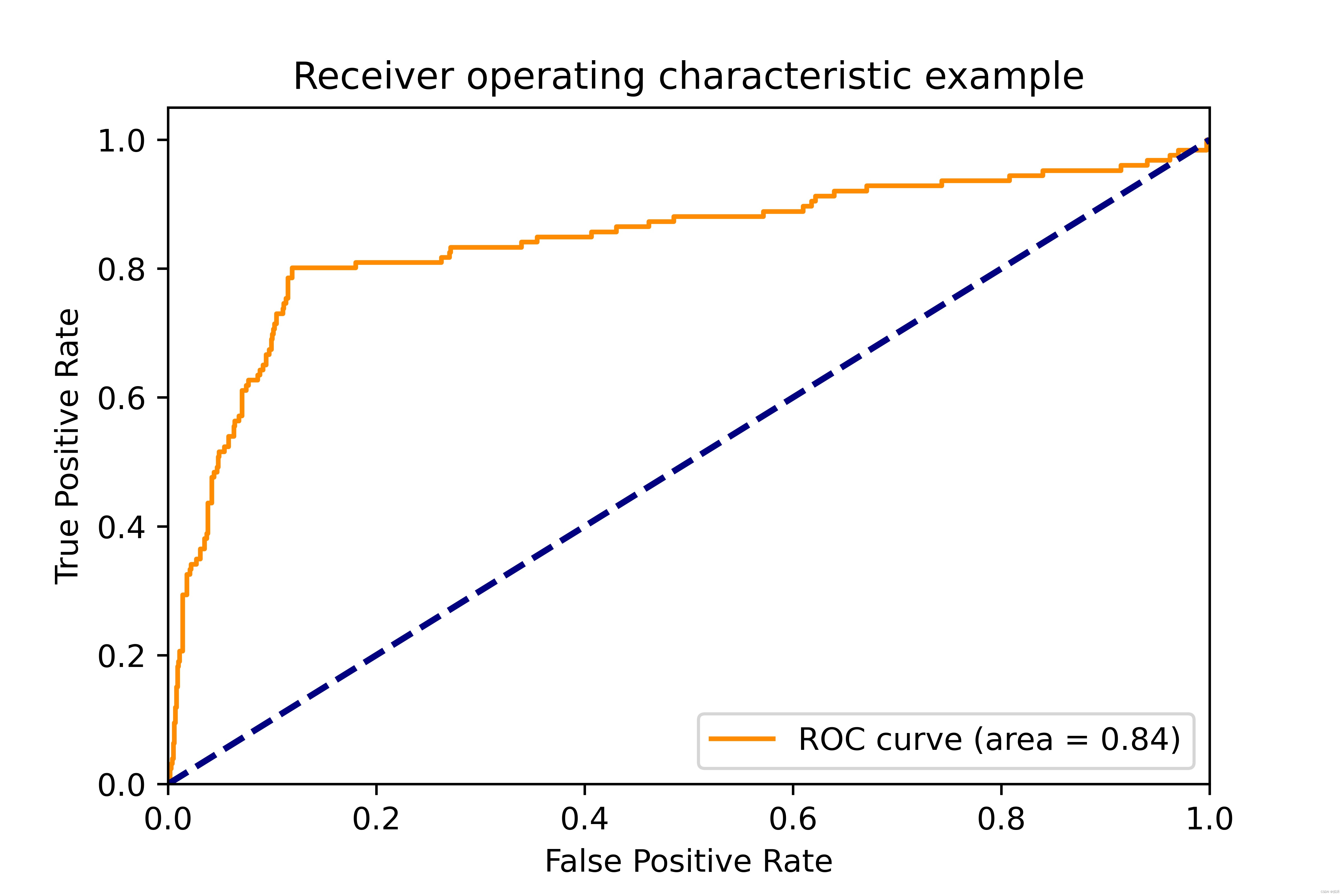ROC曲线绘制(Python)
Posted 拟 禾
tags:
篇首语:本文由小常识网(cha138.com)小编为大家整理,主要介绍了ROC曲线绘制(Python)相关的知识,希望对你有一定的参考价值。

首先以支持向量机模型为例
先导入需要使用的包,我们将使用roc_curve这个函数绘制ROC曲线!
from sklearn.svm import SVC
from sklearn.metrics import roc_curve
from sklearn.datasets import make_blobs
from sklearn. model_selection import train_test_split
import matplotlib.pyplot as plt
%matplotlib inline
然后使用下面make_blobs函数,生成一个二分类的数据不平衡数据集;
使用train_test_split函数划分训练集和测试集数据;
训练SVC模型。
X,y = make_blobs(n_samples=(4000,500), cluster_std=[7,2], random_state=0)
X_train,X_test,y_train, y_test = train_test_split(X,y,random_state=0)
clf = SVC(gamma=0.05).fit(X_train, y_train)

fpr,tpr, thresholds = roc_curve(y_test,clf.decision_function(X_test))
plt.plot(fpr,tpr,label='ROC')
plt.xlabel('FPR')
plt.ylabel('TPR')
从上面的代码可以看到,我们使用roc_curve函数生成三个变量,分别是fpr,tpr, thresholds,也就是假正例率(FPR)、真正例率(TPR)和阈值。
而其中的fpr,tpr正是我们绘制ROC曲线的横纵坐标,于是我们以变量fpr为横坐标,tpr为纵坐标,绘制相应的ROC图像如下:


值得注意的是上面的支持向量机模型使用的decision_function函数,是自己所特有的,而其他模型不能直接使用。

比如说我们想要使用其他模型(例如决策树模型)的结果绘制ROC,直接套用上面的代码,会报错,会显示没有这个函数。

以决策树模型为例,解决上述问题(适用于除向量机外的模型)
导入决策树模型包以及训练模型的代码省略了,只需要手动改一改就行了,我们直接看绘图的代码!
fpr,tpr, thresholds = roc_curve(y_test,clf.predict_proba(X_test)[:,1])
plt.plot(fpr,tpr,label='ROC')
plt.xlabel('FPR')
plt.ylabel('TPR')可以看到我们直接把只适用于支持向量机模型的函数decision_function更改成predict_proba(X_test)[:,1]就行了,让我们看看结果:

可以看到哈,决策树模型在这个数据集上的泛化能力不如支持向量机哈!!!学废了吗。
更好看的画法
auc = roc_auc_score(y_test,clf.predict_proba(X_test)[:,1])
# auc = roc_auc_score(y_test,clf.decision_function(X_test))
fpr,tpr, thresholds = roc_curve(y_test,clf.decision_function(X_test))
plt.plot(fpr,tpr,color='darkorange',label='ROC curve (area = %0.2f)' % auc)
plt.plot([0, 1], [0, 1], color='navy', lw=2, linestyle='--')
plt.xlim([0.0, 1.0])
plt.ylim([0.0, 1.05])
plt.xlabel('False Positive Rate')
plt.ylabel('True Positive Rate')
plt.title('Receiver operating characteristic example')
plt.legend(loc="lower right")
plt.savefig('suhan.jpg',dpi=800)
plt.show()
ROC曲线的绘制,python实现
ROC
结果

源数据:鸢尾花数据集(仅采用其中的两种类别的花进行训练和检测)
Summary
features:[‘sepal length (cm)‘, ‘sepal width (cm)‘, ‘petal length (cm)‘, ‘petal width (cm)‘]
实例:[5.1, 3.5, 1.4, 0.2]
target:‘setosa‘ ‘versicolor‘ (0 , 1)
采用回归方法进行拟合得到参数和bias
model.fit(data_train, data_train_label)
对测试数据进行预测得到概率值
res = model.predict(data[:100])
与训练集labels匹配后进行排序(从大到小)
pred labels
68 0.758208 1
87 0.753780 1
76 0.745833 1
50 0.743156 1
65 0.741676 1
75 0.739117 1
62 0.738255 1
54 0.737036 1
52 0.733625 1
77 0.728139 1
86 0.727547 1
74 0.726261 1
58 0.725150 1
71 0.724719 1
36 0.724142 0
14 0.723990 0
31 0.721648 0
41 0.720308 0
72 0.717723 1
79 0.712833 1
97 0.705148 1
51 0.702838 1
35 0.702203 0
98 0.701731 1
92 0.701106 1
82 0.700661 1
53 0.700465 1
18 0.699350 0
16 0.696915 0
64 0.693333 1
.. ... ...
33 0.658937 0
96 0.656761 1
30 0.656279 0
57 0.655673 1
4 0.652616 0
85 0.648620 1
59 0.648586 1
19 0.646965 0
70 0.646262 1
88 0.644482 1
8 0.643191 0
38 0.642704 0
3 0.640933 0
55 0.640630 1
47 0.640444 0
95 0.639552 1
13 0.639050 0
22 0.638485 0
29 0.635590 0
90 0.634376 1
37 0.632224 0
6 0.631119 0
46 0.630037 0
11 0.629718 0
66 0.627807 1
42 0.624795 0
44 0.621703 0
32 0.614932 0
24 0.603874 0
84 0.603249 1
计算训练集中正确的个数与非正确的个数
运用一下的算式进行TPR和FPR的计算
index = 0
for i in sorted_mat.values:
if i[1] == 0:
TPR.append(TPR[index])
FPR.append(FPR[index] + 1.0/F_num)
else:
TPR.append(TPR[index] + 1.0/T_num)
FPR.append(FPR[index])
index += 1
最后进行TPR和FPR的描绘
以上是关于ROC曲线绘制(Python)的主要内容,如果未能解决你的问题,请参考以下文章